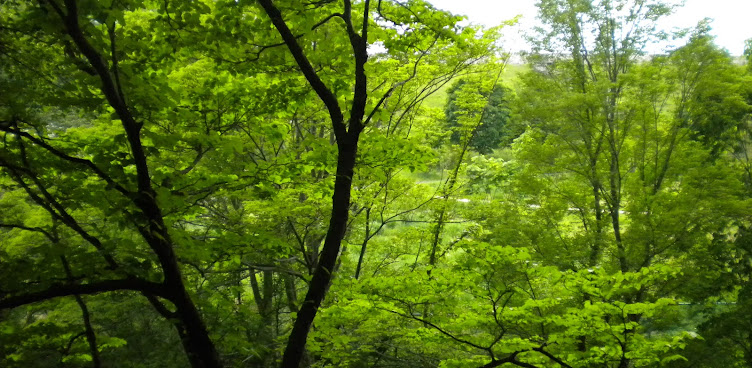Books that were repeatedly read in life
Sarashina Nikki Sarashina Diary
Translated Title As I Crossed a Bridge of Dreams
The memoirs that were written by a woman of the Heian period in Japan, about 1,000 years ago
Some poems in the Diary are below.
Sode nururu
Araiso-nami to shirinagara
Tomoni kadzuki wo
Seshi zo kohishiki
Wetting sleeves
We knew the shore was wave-beaten
Together had worked rather merrily
I miss the days with you
Yume samete
Nezame no toko no uku bakari
Kohiki to tsugeyo
Nishi he yuku tsuki
Awake out of a dream
Tears full on the bed
Tell her that I miss her, Moon
For you are going down the west
Ikani ihi
Ikani tatohete kataramashi
Aki no
Yuhube no
Sumiyoshi no ura
How to say
How to speak figurative
Autumnal
Evening
Creek Sumiyoshi
Izayoi Nikki Izayoi Diary
The diary was written by Abutsu-ni who was born in Kamakura period in Japan and died 1283.
It records her journey from Kyoto to Kamakura. Her observation to the institutions and customs on the journey was fluent and fantastic.
Diary named by the departure’s date <izayoi means the sixteenth night-the sixteenth day of the moon calendar>.
She wrote verses on occasions. The one is following.
Kari no yo no
Yukiki to miru mo hakanashi ya
Mi wo ukihune wo ukihashi ni shite
In this transient world
All the <go and come> is fleeting
As my mind and light boat are also getting to floating bridge
Sarumino
Translated Title The Monkey’s Straw Raincoat
Haikai collection that was composed by MATSUO Basho and poets of his school at 1691
First verse
Hatsu-shigure
Saru mo komino wo
Hoshigenari
In late autumn cold rain
Monkey is also seemed
To want his tiny straw raincoat
Zoku Sarumino
Following Haikai collection that was also composed by MATSUO Basho and his school poets
Last verse
Yado karite
Na wo nanorasuru
Shigure kana
For borrowing inn
Make me tell my name
Outside falls chilly autumn rain
MIYA Shuji Kasyu Anthology of MIYA Shuji
He died in 1986 at 74.
From Hakusyu Tozo published in 1986
Hachiman-sama no
Keidai no yuki ni
Hanayakani
Honen-bato no
Eda ha haewimu
Shrine Hachiman
On grounds falls snow
Brilliant
Pigeon dolls hope a good harvest in this year
Branches attached them are shining
YU Dafu Quanji Complete works of YU Dafu
He was born in China Zhejiang-sheng Guangxu 22, 1896 and killed 1945.
He modeled modern by his fine short stories in China.
From a short story in the Quanji
Deng-e maizang zhi yie Night that moth around lamp was buried
A masterpiece of modern china
In the story he speaks to her.
“Xianzai bu xiaode shenme shihou le?”
“What time is it now?”
WEN Yiduo Quanji Complete works of WEN Yiduo
He was born in China Hubei-sheng Guangxu 25, 1899 and assassinated 1946.
He obtained realities from Chinese folkways.
A main work of his career was below.
Shenhua yu shi Myths and poetry
In the above, Wenxue de lishi dongwu Recent tendency in literature contains contemporary insight toward nearly new-born China.
“Guoqu jiluli you weilaide fengse. Lishi yi gei women zhishile fangxiang-「shou」de fangxiang, rujin yaode zhi yongqi, gengduode yongqi a!”
“In past documents exists future’s scenery. History already gave us a guideline-<receiving>, what is necessary now is only courage, furthermore courage!”
ZHANG Taiyan Guoxue Jiangyan Lu ZHANG Mingfei Bishu Lecture note of ZHANG Taiyan Note-taken by ZHANG Mingfei
He was born in China Zhejiang-sheng 1869 and died 1936.
This lecture is concise and keen on Chinese classics.
Lecture date is not unknown.
The following is removed from the lecture.
“Zhongguo gushi zhi suowei tian, suowei shangdi, ze fei renqun, shi genben shang yi fei zhongjiao yie.”
“ In China, ancient times so called heaven, is heaven’s emperor, is not people’s king, so absolutely not religion from the beginning.
“Shuqiannen fangyian wenzi zhi bianqian, nai zhunf xue, gu bubi jinren jie tong, ran du gushu, ze buke buming xiaoxue.”
“Changes on thousands years dialects and characters naturally brought expert studies. All the people do not need to understand the studies. But For apprehending classics, it is absolutely necessary to be well versed in <xiaoxue>, i.e. <small study-radical study on characters>.
February 25, 2007
Tokyo March 1, 2007 Added
